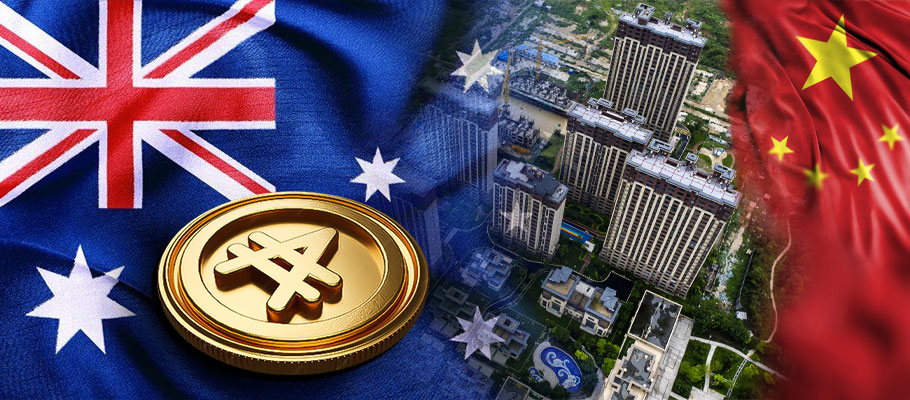
Published: September 27th, 2023
The Australian Dollar was on the back foot against G10 peers like the Pound in early trading this week as fresh worries about China's property sector spilled over into currency markets. Real estate stocks have weighed on Chinese economic underperformance over the past 12 months, leading to bouts of AUD weakness.
A report by Bloomberg said that Chinese property stocks fell to their worst valuations in eight months as worry about a possible liquidation of the country’s giant Evergrande Group pointed to stress across the sector.
Evergrande, a China's largest property developer, saw its stock sink by 25 per cent after it called off meetings with major creditors at the last minute and announced its debt restructuring plan needed to be re-visited.
The biggest stock market casualty, however, was China Aoyuan Group, which sank by a record 75 per cent when markets resumed trading on Tuesday.
Growth in China’s property market is a core driver of demand for iron ore and other construction-related raw materials, essential exports for commodity-reliant Australia.
Analysts at Westpac’s forex strategy unit wrote that China’s tepid growth and investor worries over the property sector were putting pressure on AUD. 'We expect to see occasional rallies at times but the trend into October will likely remain on the down.’
Westpac says investor sentiment with regards to China will be the core driver of AUD valuations this week, given a relatively quiet domestic news cycle Down Under.
Earlier in March, AUD was under pressure when the Reserve Bank of Australia (RBA) signaled that its cycle of interest rate rises might be coming to a close. Data from China was also influential, spooking traders with news that Chinese imports had fallen year-on-year by more than 10 per cent.
Central bankers raised interest rates by the 25 basis points traders were anticipating, however the text of the announcement suggested the RBA was giving itself wiggle room to shutter its current hiking cycle.
In the aftermath of the announcement, AUD dropped to the bottom of the G10 performance list. An analyst note from RBC Capital Markets FX Strategy Unit said that the Aussie wasn't being helped by soft Chinese import figures and an apparent hotting up in diplomatic tensions between Washington and Beijing.
The RBA also cut a previous reference to ‘additional interest rate rises’ and replaced it with the phrase ‘further tightening’.
RBC analysts said the change provided more space for monetary policy maneuver, including restricting rises to just one more hike.
'We read the RBA’s most recent interest rate statement as unequivocally dovish.’ Major AUD pairs were quick to respond, with the Pound to Australian Dollar rate rallying over half a per centage point to reach 1.7949.
‘We are looking now for the RBA to pause its tightening cycle,’ RBC’s note added. ‘For that reason we think AUD/GBP will fall below our forecast of 0.59 by the end of the current quarter.’ AUD/USD, meanwhile, dipped a quarter of a per cent lower to touch 0.6712.
At time of the RBA announcement, the Aussie was down against almost all of its G10 peers across 24-hour, seven day, and 30-day timeframes.
In March 2022 AUD found itself up against the Euro, Dollar, and British Pound as forex traders reacted to signals that an interest rate by the Reserve Bank of Australia may be in the offing.
Minutes from the RBA's February 2022 policy meeting suggested interest rates could rise as quickly as mid-April, far earlier than the central bank had been signaling since the start of this year.
In fact, RBA Governor Phil Lowe told Bloomberg in January 2022 that the bank was ‘being patient’ on interest rates ‘in a way that markets with much higher rates of inflation simply (couldn’t).’
After that, inflation Down Under rose steadily and RBA policymakers got the jitters. The bank’s February minutes said yearly core inflation in the first quarter of 2022 would likely exceed its top target of two to three per cent.
The minutes were published one week before the country's official inflation figures for Q1 are set to be released on 26th April. Consensus is looking for headline inflation of 3.1 per cent year-on-year in the first quarter.
‘Inflation had accelerated, and another increase was expected,’ the RBA said, ‘with measures of underlying inflation in the first quarter anticipated to be north of three per cent.’
The minutes highlighted what was then a robust domestic economy, strengthened by rising consumer spending thanks to the passing of the Omicron COVID wave, plus a tightening jobs market.
Rising house prices and an uptick in commodity exports were also highlighted, while members of the bank’s policy committee were in agreement that the RBA’s policy settings were ‘very accommodative’.
Despite that, the minutes emphasized that the central bank wanted to see new data on both labour costs before and inflation before lifting interest rates.
Following the release of the February 2022 minutes, AUD was the best performing G10 currency, posting gains of 0.35 per cent against Sterling, 0.30 per cent against the Dollar, and 0.33 per cent against the Euro.
In a market commentary, forex analysts at Westpac said the RBA Board was ‘devoting more attention to global inflation risks while gauging the responses of other central banks.’ The timetable for rate hikes has been accelerated around the world, Westpac said, and there is concern that markets may be underestimating the inflation challenge.
Markets expectations for a RBA rate hike had risen steadily through most of late 2021 and early 2022, bidding AUD higher as a result.
While the RBA was signaling that it was resisting further rate rises, forex traders were starting to call its bluff by pricing in a significant number of rate hikes.